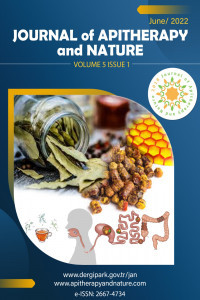The Immune Modulatory and Anti-protozoal Effects of Different Propolis Samples
The Immune Modulatory and Anti-protozoal Effects of Different Propolis Samples
Propolis, Anti-protozoal Effects,
___
- 1. Ravoet, J.; Schwarz, R.S.; Descamps, T.; Yañez, O.; Tozkar, C.O.; Martin-Hernandez, R.; Bartolomé, C.; De Smet, L.; Higes, M.; Wenseleers, T. Differential diagnosis of the honey bee trypanosomatids Crithidia mellificae and Lotmaria passim. Journal of invertebrate pathology 2015, 130, 21-27. 2. Schwarz, R.S.; Bauchan, G.R.; Murphy, C.A.; Ravoet, J.; Graaf, D.C.; Evans, J.D. Characterization of two species of trypanosomatidae from the honey bee Apis mellifera: Crithidia mellificae langridge and mcghee, and Lotmaria passim n. Gen., n. Sp. Journal of Eukaryotic Microbiology 2015, 62, 567-583.
- Yayın Aralığı: Yılda 2 Sayı
- Başlangıç: 2018
- Yayıncı: Oktay YILDIZ
Shankar KATEKHAYE, Hugo FEARNLEY, James FEARNLEY, Anant PARADKAR
Fatty Acid Analysis and Biological Activity of Jordanian Propolis
Ashok K. SHAKYA, Shankar KATEKHAYE, Ghaleb A. ORIQUAT, Rajashri R. NAIK, Rajashri R. NAIK, Anant PARADKAR, Hugo FEARNLEY, James FEARNLEY
Bíliková KATARÍNA, Yamaguchi YOSHIHISA
Chemical Profiling of Tropical Propolis: Challenges and New Data
Milana POPOVA, Boryana TRUSHEVA, Kristina GEORGIEVA, Vassya BANKOVA
Emerging Impact of Bee Propolis for Gut Health: Evidence and Mechanisms
Kai WANG, Xiaolu JIN, Qiangqiang LI, Alexandra Christine Helena Frankland SAWAYA, Richard K. Le LEU, LEU4, Michael A. CONLON, Liming WU, Fuliang HU
Effect of Brazilian Propolis-containing Ointment on Genital Itching in Menopausal Women
Hiroshi MIURA, Yasuko MIURA, Yuki SHIMODA, Satoko KAGABU, Hiromitsu TSUBAKI, Yukihiro TERADA
Flavonoids Constituents of Algeria Propolis
Segueni NARIMANE, Jesus. G. DIAZ, Akkal SALAH, Rhouati SALAH
Propolis: Pharmacological Properties and Medical Applications of Propolis in Modern Medicine
In Vitro Evaluation of Green and Red Propolis Extracts Against Candida spp
M. D. FREITAS, G. A. LOPES, N. A OLIVEIRA, B. M. ALMEIDA, S. R. L. ABREU, R. C. BASQUES, N. S. BINDA, S. M. FIGUEIREDO
An Exploration into the Relationship Between Propolis Production and Trypanosome Burden
